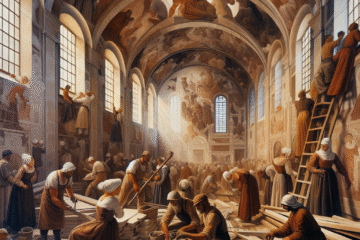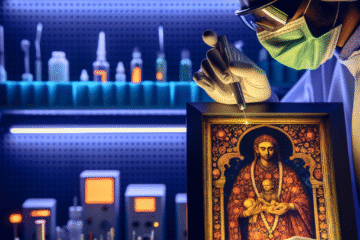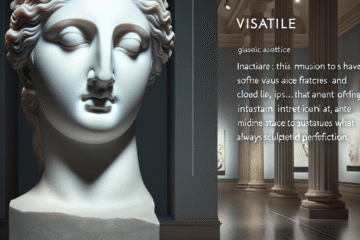I. Introduction
- Definition of the Baroque era
- Overview of the artistic, cultural, and political climate of the time
The Baroque era was a period of artistic, cultural, and political flourishing that took place from the late 16th to early 18th centuries. It is characterized by ornate details, grandeur, and a focus on dramatic effects, as well as a fascination with the supernatural and the divine.
The Baroque era saw some of the greatest artistic achievements in European history, with masterpieces in a variety of media, including painting, sculpture, architecture, and music. The Baroque style was influenced by the Renaissance, but it differed in its emphasis on emotion, drama, and the use of light and shadow to create a sense of movement and tension.
The Baroque era was also a time of great cultural and political upheaval. The Catholic Church, which had long held a dominant role in European society, was facing challenges from Protestantism and the Enlightenment, and the Baroque style was often used to reinforce the Church’s power and authority. In addition, the Baroque era saw the rise of absolutist monarchies in Europe, and the Baroque style was often used to glorify the rulers of these states.
Overall, the Baroque era was a time of great artistic and cultural achievement, but it was also marked by conflict and tension. It is a period that continues to fascinate and inspire people to this day.
II. Characteristics of Baroque Art
- Use of ornate details and dramatic effects
- Emphasis on grandeur and excess
- Role of religious and political themes
One of the defining characteristics of Baroque art is its use of ornate details and dramatic effects. Baroque artists sought to create works that were rich in texture and detail, and they used a variety of techniques to achieve this, such as chiaroscuro (the use of light and shadow to create contrast and depth), tenebrism (the use of extreme contrast between light and dark areas), and sfumato (the use of subtle gradations of color and tone to create a sense of atmospheric perspective).
In addition to their focus on ornate details, Baroque artists also placed great emphasis on grandeur and excess. Baroque works often depict scenes of great pomp and splendor, with opulent fabrics, jewels, and other luxurious details. This emphasis on grandeur was often used to convey a sense of power and authority, particularly in religious and political works.
Religion and politics played a significant role in the themes of Baroque art. Many Baroque works depict religious subjects, such as scenes from the Bible or the lives of saints. These works were often intended to reinforce the power and authority of the Catholic Church, which was facing challenges from Protestantism and the Enlightenment. In addition, Baroque art was often used to glorify the rulers of absolutist monarchies, and many works depict scenes from the lives of these rulers or depict them as heroic figures.
Overall, the characteristics of Baroque art are defined by its use of ornate details, dramatic effects, and emphasis on grandeur and excess, as well
as its frequent depiction of religious and political themes. These elements combined to create a style that was dramatic, ornate, and opulent, and that reflected the cultural and political climate of the time.
III. Major Figures in Baroque Art
- Description of the works and styles of key Baroque artists such as Caravaggio, Bernini, and Rubens
During the Baroque era, there were many talented artists who contributed to the development and evolution of the Baroque style. Some of the most notable figures in Baroque art include:
- Caravaggio: Michelangelo Merisi da Caravaggio was an Italian painter who is considered one of the founders of the Baroque style. His works are characterized by their dramatic use of light and shadow, as well as their highly realistic depiction of figures and objects. Caravaggio’s most famous works include “The Calling of St. Matthew,” “The Martyrdom of St. Matthew,” and “The Conversion of St. Paul.”
- Bernini: Gian Lorenzo Bernini was an Italian sculptor and architect who is considered one of the greatest Baroque artists. His works are characterized by their grandeur, drama, and attention to detail. Some of Bernini’s most famous works include “The Ecstasy of St. Theresa,” “David,” and the Fountain of the Four Rivers in Rome.
- Rubens: Peter Paul Rubens was a Flemish painter who is known for his lush, painterly style and his ability to convey emotion and movement in his works. Some of Rubens’s most famous works include “The Descent from the Cross,” “The Raising of the Cross,” and “The Garden of Earthly Delights.”
These three artists are just a few examples of the many talented figures who contributed to the Baroque style. Each of them had a unique style and approach to art, and their works continue to be admired and studied to this day.
IV. Impact and Legacy of the Baroque Era
- How the Baroque style influenced later artistic movements
- The lasting impact of Baroque art on popular culture
The Baroque era had a significant impact on the development of art and culture, and its influence can still be seen today.
One of the ways in which the Baroque style influenced later artistic movements was through its emphasis on drama and emotion. Many later artistic movements, such as the Romantic and Expressionist movements, were influenced by the Baroque’s emphasis on the expression of strong emotions through art.
In addition to its influence on later artistic movements, the Baroque era also had a lasting impact on popular culture. Many of the grand, ornate works of art created during the Baroque era have become iconic and are still widely recognized and admired today. For example, Bernini’s Fountain of the Four Rivers in Rome is a popular tourist attraction and a symbol of the city. Similarly, Caravaggio’s “The Calling of St. Matthew” and Rubens’s “The Garden of Earthly Delights” are well-known and widely reproduced works of art.
Overall, the Baroque era had a significant impact on the development of art and culture, and its influence can still be seen today in the way we view and appreciate art. Its dramatic, ornate works continue to captivate and inspire people to this day.
V. Conclusion
- Recap of the main points of the article
- Reflection on the enduring appeal of the Baroque era and its art.
The Baroque era was a period of artistic, cultural, and political flourishing that took place from the late 16th to early 18th centuries. It is characterized by ornate details, grandeur, and a focus on dramatic effects, as well as a fascination with the supernatural and the divine.
During the Baroque era, there were many talented artists who contributed to the development and evolution of the Baroque style. Some of the most notable figures in Baroque art include Caravaggio, Bernini, and Rubens. These artists and others created works that are known for their ornate details, dramatic effects, and emphasis on grandeur and excess.
The Baroque era had a significant impact on the development of art and culture, and its influence can still be seen today. Its emphasis on drama and emotion influenced later artistic movements, and many of the grand, ornate works of art created during the Baroque era have become iconic and continue to be admired and studied.
In conclusion, the Baroque era was a time of great artistic and cultural achievement, and its art continues to captivate and inspire people to this day. Its ornate, dramatic style and emphasis on grandeur and excess have contributed to its enduring appeal, making it a period that continues to be studied and celebrated by art enthusiasts around the world.


